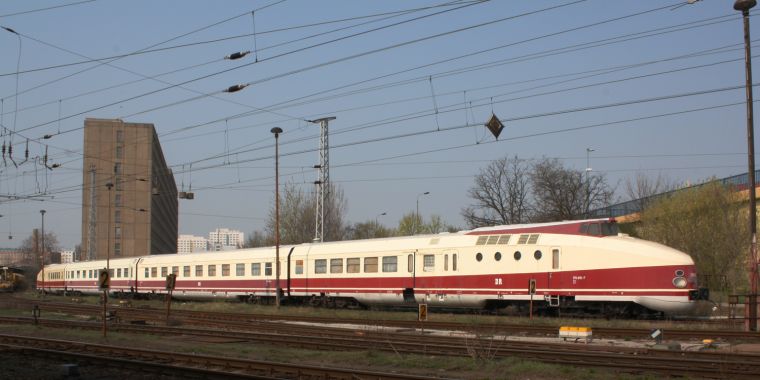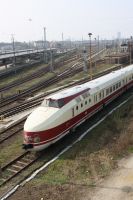VT 18.16 in Lichtenberg

Posted: 10 April 2009

This work is licensed under a Creative Commons Germany license.
Notes
Continuing with a side view. The VT 18.16 (from 1970: Class 175) can be seen as competition to the west german VT 11.5 (from 1968: Class 601) (picture by smotchy) by Deutsche Bundesbahn (DB), but both are also an example of how similar german post-war designs often were. Other examples include the V100 (west, east) or the V60 (west, east).
The history of this train starts right after the first world war. Franz Kruckenberg, an airship engineer, was out of work thanks to the Treaty of Versailles, which largely forbade Germany from building dirigibles. He instead applied the principles of airship construction to railways and first created the “Schienenzeppelin” (Rail Zeppelin), an extremely light vehicle pushed by a propeller. It reached a top speed of 230 kph (143 mph), which set the world speed record for railroads and the time and, incidentally, still is the world record for petrol-powered trains. The propeller design was inherently problematic, however, so Kruckenberg and his team instead went with a normal wheel-driven design, with a diesel motor driving the wheels via a hydraulic transmission.
That design proved to be good enough to convince the Deutsche Reichsbahn (DRG) to let him build a new DMU, the SVT 137 155, using these principles, to compare this design with the “Fliegender Hamburger” high-speed DMUs with electric transmission. Due to damages and the beginning second world war, the train never reached regular service, but it did achieve speeds of up to 215 kph (134 mph) in testing.
Still, it proved to be enough of a success that it’s basic design principles (hydraulic transmission, engine compartment in front of the raised cab, articulated train and light-weight construction) became more or less (DR decided against articulation) the blueprint for the new post-war high-speed DMUs, such as the VT 11.5 and this one.

 Deutsche Version
Deutsche Version Entire Gallery
Entire Gallery

 Next Picture
Next Picture
 Previous Picture
Previous Picture